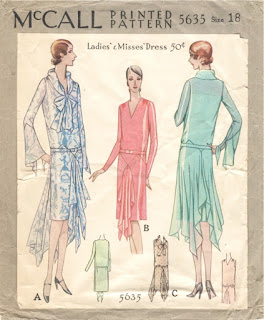Madeleine Vionnet (1877-1975) French
Madeleine Vionnet trained in the well known fashion houses of Callot Soeurs (Callot Sisters) and Jacques Doucet. While there she discovered a way to work with fabric that sealed her destiny.
Her influence is now seen in every slinky, body-skimming dress. She developed a style of three-dimensional cutting, using the three ways of fabric: lengthwise, crosswise, and bias. Cutting on bias is the practice of cutting cloth diagonal to the grain of the fabric that enables it to cling to and move with the wearer. To better accommodate the use of bias and to eliminate using multiple seams, Vionnet would order from her supplier fabrics that were two yards wider than usual for draping.
 |
| Silk cut-in-one gown, 1936. |
Her influence is now seen in every slinky, body-skimming dress. She developed a style of three-dimensional cutting, using the three ways of fabric: lengthwise, crosswise, and bias. Cutting on bias is the practice of cutting cloth diagonal to the grain of the fabric that enables it to cling to and move with the wearer. To better accommodate the use of bias and to eliminate using multiple seams, Vionnet would order from her supplier fabrics that were two yards wider than usual for draping.
 |
| Silk day dress, 1920. |
In 1912 she founded Vionnet, her own fashion house. She was one of the first designers (along with Poiret and Chanel) to liberate women from corsets. Her designs produced sensuously shaped, floating dresses with lowered waistlines that transformed Greek and Medieval inspirations into distinctly modern clothes made in silk, organdy, chiffon, velvet, and clinging lamé.
 |
| Silk pin-tuck dress, 1926-27. |
Unlike other designers of the times, her dresses defied copying. To obtain the patterns her designs would have to be disassembled and laid flat in order to be understood. Some of her dresses, shapeless on the hanger, only made sense when viewed on the body and some even required instructions to wear!
To learn more about her work and method, you can consult Vionnet by Betty Kirke and the book’s complementary Japanese volume with reproducible patterns and photos of their reproductions published by the Bunka Fashion College -Vionnet Research Group who studied and recreated the work of Vionnet according to Kirke’s researched methods. Another book, Patterns of Fashion 2: 1860-1940 by Janet Arnold includes five patterns from Vionnet. View a completed project here.
 |
| Silk evening dress, 1939. |
 |
| Rayon gown, 1938. |
Hollywood Connection: She worked uncredited on 1931’s The Bachelor Father starring Marion Davies, fashion plate and tycoon William Randolph Hearst’s mistress. On the movie, she worked alongside fellow uncredited designers John Redfern, Captain Edward Molyneux, and Gilbert Adrian.
- Through her reliance on bias cutting, she was the first to design a dress without fasteners that could be slipped on over the head.
- The use of crepe de chine as a dress fabric when it was formerly only used for lining coats.
- She pioneered innovative seam decoration with her visible seams sometimes forming star or flower shapes.
- The elimination of interfacing in order to keep the fabrics and the silhouettes flexible.
- Characteristic Vionnet inventions included the handkerchief dress, the cowl neckline, and the halter neck dress.
Images: Costume Institute at The Metropolitan Museum of Art, the Museum at Fashion Institute of Technology.
Sources: Dressmakers of France, (1956) Mary Brooks Pickens, Dora Loues Miller; Secrets of the Couturiers, (1984) Frances Kennett; Fashion (2003) Christopher Breward; 100 Dresses, (2010) Costume Institute at The Metropolitan Museum of Art; Who’s Who in Fashion (1980) Anne Stegemeyer.





No comments:
Post a Comment